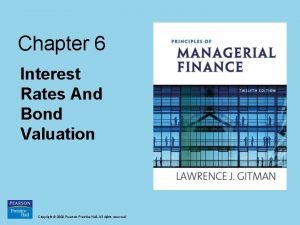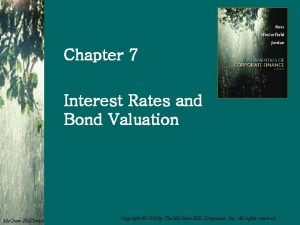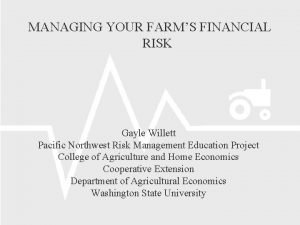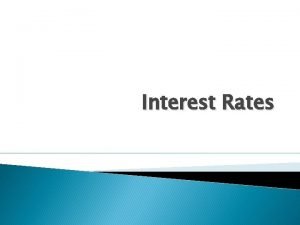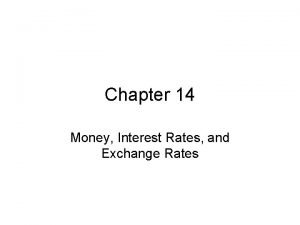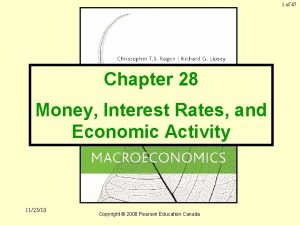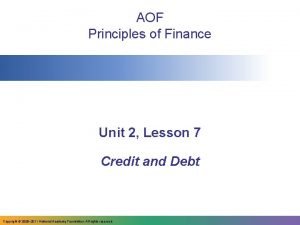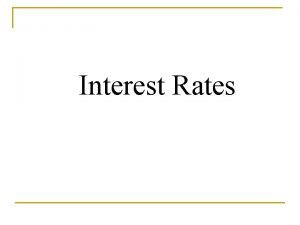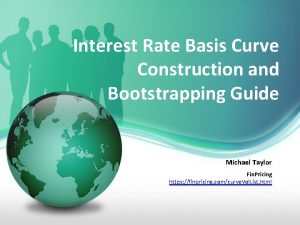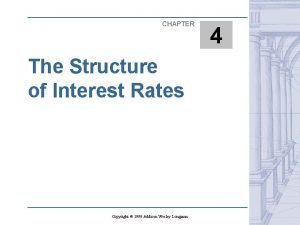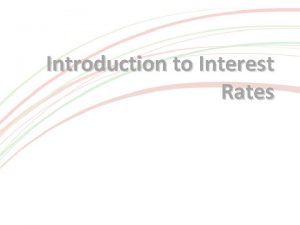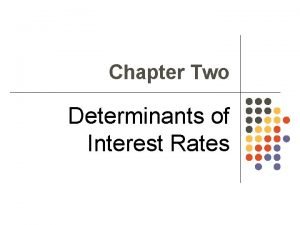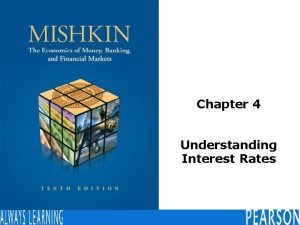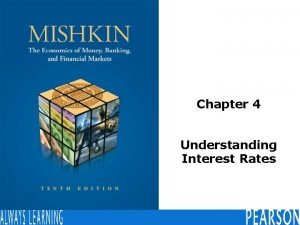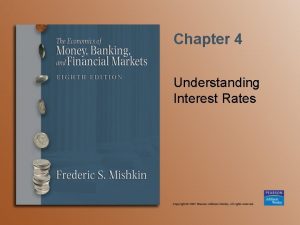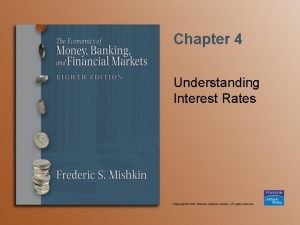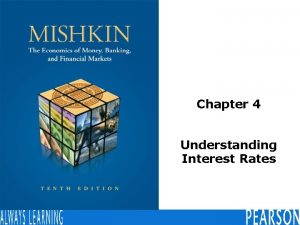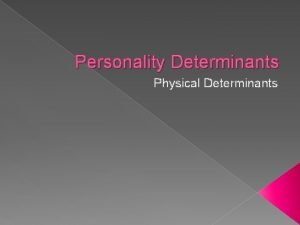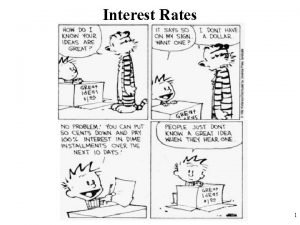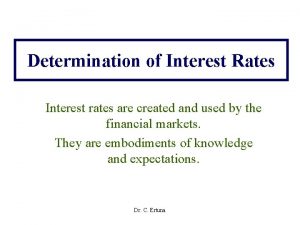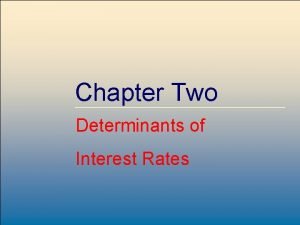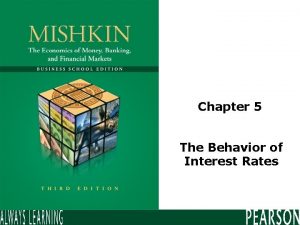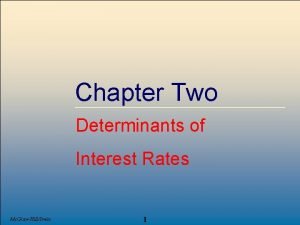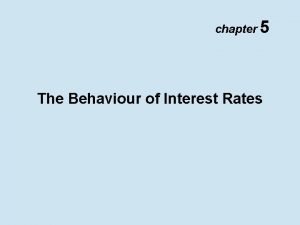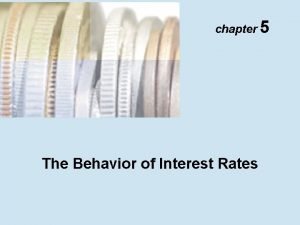CHAPTER 6 Interest Rates n n Determinants of





















- Slides: 21

CHAPTER 6 Interest Rates n n Determinants of interest rates The term structure and yield curves 6 -1

What four factors affect the level of interest rates? n Production opportunities n n Time preferences for consumption n n The supply of money Risk n n The demand for money The chances of getting a zero or negative return Expected inflation n Will your money buy less in the future? 6 -2

“Nominal” vs. “Real” rates r = represents any nominal rate r* = represents the “real” risk-free rate of interest. Like a T-bill rate, if there was no inflation. Typically ranges from 1% to 4% per year. r. RF = represents the rate of interest on Treasury securities. 6 -3

Determinants of interest rates r = r* + IP + DRP + LP + MRP r r* IP DRP LP MRP = = = required return on a debt security real risk-free rate of interest inflation premium default risk premium liquidity premium maturity risk premium 6 -4

Premiums added to r* for different types of debt IP S-T Treasury L-T Treasury S-T Corporate L-T Corporate MRP DRP LP 6 -5

Yield curve and the term structure of interest rates n n n Term structure – relationship between interest rates (or yields) and maturities. The yield curve is a graph of the term structure. The November 2005 Treasury yield curve is shown at the right. 6 -6

Yield Curves for 1980, 2000, & 2008 6 -7

Sample problem: Constructing the yield curve for Treasuries n n n Suppose most investors expect the inflation rate to be 5% next year, 6% the following year, and 8% thereafter. The real risk-free rate is 3%. The maturity risk premium is 0 for bonds that mature in 1 year or less, 0. 1% for 2 -year bonds, and then MRP increases by 0. 1% per year thereafter for 20 years. What is the interest rate for 1 -year, 10 -year, and 20 year Treasury bonds? Draw a yield curve with this data. (Note: this is problem 6 -21 e on page 192) 6 -8

Sample problem: Constructing the yield curve for Treasuries (continued) n Step 1 – For each of the bonds, we will find the average expected inflation rate over years 1 to N: Assume inflation is expected to be 5% next year, 6% the following year, and 8% thereafter. IP 1 = 5% / 1 = 5. 00% IP 10= [5% + 6% + 8%(8)] / 10 = 7. 50% IP 20= [5% + 6% + 8%(18)] / 20 = 7. 75% 6 -9

Sample problem: Constructing the yield curve for Treasuries (continued) n Step 2 – Find the appropriate maturity risk premium (MRP). For this example, the following equation will be used find a security’s appropriate maturity risk premium. Using the given equation: MRP 1 = 0. 1% x (1 -1) = 0. 0% MRP 10 = 0. 1% x (10 -1) = 0. 9% MRP 20 = 0. 1% x (20 -1) = 1. 9% 6 -10

Add the IPs and MRPs to r* to find the appropriate nominal rates r = r* + IP + DRP + LP + MRP, but for Treasury securities, liquidity premium (LP) and default risk premium (DRP) are 0. Step 3 – Use IP and MRP to calculate the nominal rates. r. RF, t = r* + IPt + MRPt We are told to assume real risk-free rate r* = 3%: r. RF, 10 r. RF, 20 = 3% + 5. 0% + 0. 0% = 8. 0% = 3% + 7. 5% + 0. 9% = 11. 4% = 3% + 7. 75% + 1. 9% = 12. 65% 6 -11

Use the data to draw the yield curve Interest Rate (%) 15 n Maturity risk premium n 10 Inflation premium 5 Real risk-free rate 0 1 10 An upward sloping yield curve. Upward slope due to an increase in expected inflation and increasing maturity risk premium. Years to 20 Maturity 6 -12

What is the relationship between the Treasury yield curve and the yield curves for corporate issues? n Corporate yield curves are higher than that of Treasury securities, though not necessarily parallel to the Treasury curve. For corporates: n n n Default risk is > 0 Default risk increases for longer maturities Longer maturities are less liquid, so LRP increases Spread over Treasuries widens as maturity increases The spread between corporate and Treasury yield curves widens as the corporate bond rating decreases (i. e. , as default risk increases) 6 -13

Illustrating the relationship between corporate and Treasury yield curves Interest Rate (%) 15 BB-Rated 10 AAA-Rated 5 Treasury 6. 0% Yield Curve 5. 9% 5. 2% Years to 0 0 1 5 10 15 20 Maturity 6 -14

Pure Expectations Hypothesis n n The PEH contends that the shape of the yield curve depends on investor’s expectations about future interest rates. If interest rates are expected to increase, L-T rates will be higher than S-T rates, and vice-versa. Thus, the yield curve can slope up, down, or even bow. 6 -15

Assumptions of the PEH n n n Assumes that the maturity risk premium for Treasury securities is zero. n For Treasuries, we used r. RF, t = r* + IPt + MRPt , n For PEH, we’ll use r. RF, t = r* + IPt Long-term rates are an average of current and future short-term rates. If PEH is correct, you can use the yield curve to “back out” expected future interest rates. 6 -16

Sample problem 6 -21 h on page 193 Maturity 1 year 2 years 3 years 4 years 5 years Yield 6. 0% 6. 2% 6. 4% 6. 5% If PEH holds, what does the market expect will be the interest rate on one-year securities, one year from now? n What does the market expect will be the interest rate on 3 -year securities, 2 years from now? n 6 -17

Sample problem 6 -21 h (continued): Calculate the one-year forward rate 6. 0% x% 0 1 2 6. 2% (1. 062)2 1. 12784/1. 060 6. 4004% n = (1. 060) (1+x) =x PEH says that one-year securities will yield 6. 4004%, one year from now. 6 -18

Sample problem 6 -21 h (continued): Calculate three-year forward rate expected 2 years from now 6. 2% 0 1 x% 2 3 4 5 6. 5% (1. 065)5 1. 37009/1. 12784 6. 7005% n = (1. 062)2 (1+x)3 =x PEH says that three-year securities will yield 6. 7005%, two years from now. 6 -19

Conclusions about PEH n Some would argue that the MRP ≠ 0, and hence the PEH is incorrect. n n r. RF, t = r* + IPt + MRPt Most evidence supports the general view that lenders prefer S-T securities, and view L-T securities as riskier. n Thus, investors demand a premium to persuade them to hold L-T securities (i. e. , MRP > 0). 6 -20

Other factors that influence overall interest rate levels n n Federal reserve policy Federal budget surplus or deficit Level of business activity International factors You probably remember these factors from your economics course. These factors are discussed on pages 183 -185. 6 -21
 Determinants of interest rates
Determinants of interest rates Chapter 7 interest rates and bond valuation
Chapter 7 interest rates and bond valuation Your uncle would like to restrict his interest rate risk
Your uncle would like to restrict his interest rate risk Chapter 6 interest rates and bond valuation
Chapter 6 interest rates and bond valuation Chapter 7 interest rates and bond valuation
Chapter 7 interest rates and bond valuation Chapter 6 interest rates and bond valuation
Chapter 6 interest rates and bond valuation Is a ratio a rate
Is a ratio a rate Ratios guided notes
Ratios guided notes Ratios rates and unit rates
Ratios rates and unit rates Ratios rates and unit rates
Ratios rates and unit rates Ssema
Ssema Graphing monetary and fiscal policy interactions
Graphing monetary and fiscal policy interactions Disadvantages of high interest rates
Disadvantages of high interest rates Quotes about adjustments
Quotes about adjustments Increase money supply
Increase money supply Interest rates and price level
Interest rates and price level Effective interest vs nominal interest
Effective interest vs nominal interest Personal finance unit 2 lesson 2
Personal finance unit 2 lesson 2 Nominal v. real interest rates
Nominal v. real interest rates Interest rates
Interest rates Interest rate curve construction
Interest rate curve construction Interest rates
Interest rates



